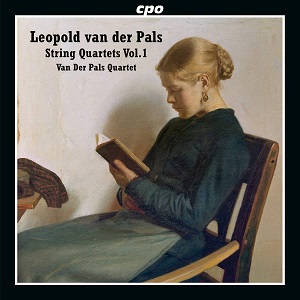
Leopold van der Pals (1884-1966)
String Quartets Volume 1
String Quartet No 1, Op 33 (1916-17)
String Quartet No 2, Op 66 (1925)
String Quartet No 3, Op 79 “Metamorphosen” (1929)
In Memoriam Marie Steiner, Op 176 (1948)
Van Der Pals Quartet
rec. 2019, Helsingborg, Sweden
cpo 555 282-2 [66]
The String Quartet No 1 emerged in 1916–1917. It’s the longest of the three on this disc and its first movement immediately acclimatises the listener to the composer’s predilection for emotional ice floes, intricate interplayed melody and scorched earth complexity. This has something of the density of Franz Schmidt’s string writing. What we also get is tenderness, which proves to be a Van der Pals ‘hallmark’. The clamant dramatic aspect – a subsidiary seam – reflects a heaving cauldron of emotions. The second movement – reminiscent of Schoeck and a little of early Berg – tends to noodle and can become becalmed in an emotional sargasso. That said, it’s irresistible and what it does is done most beauteously. The finale is animated; a return to the propulsive thrust of the first movement. The work ends masterfully, as in a dancing field of sea-weed, with each dactyl sinuously mobile.
The Second Quartet is, like the Third, in four quite short movements. It was composed in the Ticino region of Switzerland where Leopold and his wife Marussja had a year in the mountains. Again we encounter that matte density of texture from which a Scriabin-like striving for the unattainable occasionally struggles free. The climax of the Adagio is a long, high-lying cello solo. This pietistic tenderness slowly slips into a sanctum of introspection. The Scherzo brings the breeze of release: flailing along like a bird at sea in a storm. The work concludes moodily as the sun sets in the Far West.
Metamorphosen is the title of the Third Quartet (1929) which is even shorter than the Second. It was composed in only four days. It comes as no surprise that this has about it nothing of the circus maximus. A distilled essence of elegy in solution with cantilena, it sounds rather like Villa-Lobos’s Bachianas Brasileiras No 5. The two middle movements occupy themselves with tenderness and fury before a finale that plunges into a furious emotional maelstrom. From this, the composer soon turns abruptly away in an almost perfunctory and undramatically dismissive final wave.
The very short In Memoriam Marie Steiner is a work written three years after the Second World War. The person in whose memory it was written was a close acquaintance. The work’s emotional tug is undeniable. It’s a work of murmurous and solicitous tenderness which proclaims a family resemblance to the ubiquitous Barber Adagio; a work to which this Van der Pals miniature is a sister under the epidermis.
Van der Pals stands tall with a gift for cat’s-cradle of tenderness caught in a viscous tonal velour and alternated with seismic emotional turbulence.
How can we be sure without a performing tradition in such unfamiliar music, but the players here give every sign of having a grip on the music. That grip in turn exerts a grip on the listener. This is aided by a recording that pays attention to inner detail and to the massed impact of a quartet playing at full stretch.
The supportively helpful and presumably authoritative notes are in the usual spread of languages, including English. They are by Tobias van der Pals, grandson of the composer, who is the cellist of the Van der Pals Quartet.
Rob Barnett
Help us financially by purchasing from




















